Nissan Motor Co. witnessed a staggering 12% drop in its shares, marking the largest decline in over two decades, following disappointing quarterly earnings and a downward revision in car sales estimates due to intensified competition in China. This significant tumble underscores the challenges faced by foreign automakers in China’s rapidly evolving automotive landscape, with domestic brands like BYD gaining ground and intensifying pressure on established players like Nissan.
The renowned Japanese automaker, Nissan, which once held the title of China’s largest market until 2022, now finds itself grappling with market share losses amidst stiff competition from domestic rivals and a prolonged recovery from internal upheavals triggered by the ousting of former Chairman Carlos Ghosn. With its brand equity and value in China trailing behind competitors like Toyota and Honda, Nissan faces heightened vulnerability in a market where Chinese automakers are aggressively pursuing market share.
The precipitous decline in Nissan’s shares on Friday, erasing approximately USD 1.8 billion of its market value, followed its third-quarter operating profit falling significantly short of analyst expectations and a downward revision of its global vehicle sales outlook by 150,000 cars to 3.55 million. The company’s Chief Financial Officer, Stephen Ma, attributed this revision primarily to its lacklustre performance in China, where sales have plummeted by 25% over the past nine months, compounded by heightened competition in other key markets, including the United States.
Amidst the cutthroat competition in China’s automotive market, Nissan’s net revenue per vehicle experienced an 8% decline, fueling concerns of operating in a “zero-margin business.” This challenging landscape has prompted calls for Japanese automakers like Nissan to adapt swiftly to Chinese consumer preferences, particularly towards tech-centric features that local manufacturers are adept at providing.
In response to these challenges, Nissan is exploring strategies to bolster its competitiveness, including adjusting incentives and focusing on cities and regions in China where electrification adoption is slower. Furthermore, Nissan announced plans to commence car exports from China to other overseas markets by 2025, aiming for initial annual volumes of 100,000 to 200,000 vehicles, as part of its efforts to leverage excess production capacity and shore up its global presence.
However, analysts caution that leveraging production capacity in China for exports may yield limited returns on invested capital, highlighting the complexity and uncertainties that lie ahead for Nissan as it navigates through China’s dynamic automotive landscape. Despite the headwinds, Nissan remains committed to securing its position in China and aims to emerge as a significant player in the country’s evolving automotive industry.



